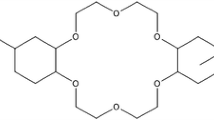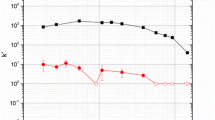Abstract
A crown-ether based extraction chromatography resin, Eichrom Pb, has been characterized for separations of the flerovium (Fl) pseudo-homolog Hg. Previous results on the batch uptake of Pb(II) and Sn(IV) are compared with newly investigated Hg(II) in HCl matrices. It was determined that all three elements can be strongly retained by the resin at different HCl concentrations. To assess the feasibility for performing an experiment on the chemical properties of Fl using this resin the extraction kinetics were studied. A separation method for the isolation of the homologs Pb(II) and Sn(IV) and pseudo-homolog Hg(II) has been established using 2 mL pre-packed Pb resin columns under vacuum flow.




Similar content being viewed by others
References
Despotopulos JD, Kmak KN, Gharibyan N, Henderson RA, Moody KJ, Shaughnessy DA, Sudowe R (2016) Characterization of the homologs of flerovium with crown ether based extraction chromatography resins: studies in hydrochloric acid. J Radioanal Nucl Chem 310:1201–1207
Pitzer KS (1975) Are elements 112, 114, and 118 relatively inert gases? J Chem Phys 63:1032–1033
Nash CS (2005) Atomic and molecular properties of elements 112, 114 and 118. J Phys Chem A 109:3493–3500
Liu W, van Wüllen C, Han YK, Choi YJ, Lee YS (2001) Spectroscopic constants of Pb and Eka-lead compounds: comparison of different approaches. Adv Quant Chem 39:325–355
Hoffman DC, Lee DM, Pershina V (2006) In: Vertes A, Klencsar Z (eds) The chemistry of the actinide and transactinide elements. Springer, Dordrecht, pp 1652–1752
Francis T (2002) Liquid-liquid extraction and separation of mercury from industrial wastes. (Doctoral dissertation). Regional Research Laboratory (CSIR), India
Roesmer J, Kruger P (1960) The radiochemistry of mercury. National Academy of Sciences-National Research Council, Washington D.C
Seth M, Faegri K, Schwerdtfeger P (1998) The stability of the oxidation state +4 in group 14 compounds from carbon to element 114. Angew Chem Int Ed Engl 37:2493–2496
Nervik WE (1960) The radiochemistry of tin. Subcommittee on radiochemistry. National Acadamy of Sciences-National Research Council, Washington D.C
Gibson WM (1961) The radiochemistry of lead. National Academy of Sciences-National Research Council, Washington D.C
Horwitz EP, Dietz ML, Rhoads S, Felinto C, Gale NH, Houghton J (1994) A lead-selective extraction chromatographic resin and its application to the isolation of lead from geological samples. Anal Chim Acta 292:263–273
Despotopulos JD, Kmak KN, Gharibyan N, Brown TA, Grant PM, Henderson RA, Moody KJ, Tumey SJ, Shaughnessy DA, Sudowe R (2015) Production and isolation of homologs of flerovium and element 115 at the Lawrence Livermore National Laboratory Center for Accelerator Mass Spectrometry. J Radioanal Nucl Chem 308:567–572
Despotopulos JD (2015) Studies of flerovium and element 115 homologs with macrocyclic extractants (Doctoral dissertation). ProQuest Ann Arbor 3715057:224
“National Nuclear Data Center “NNDC” (2013) Brookhaven National Laboratory, [Online]. http://www.nndc.bnl.gov. Accessed 16 Oct 2016
Horwitz EP, Bloomquist CA (1972) Preparation, performance, and factors affecting band spreading of high-efficiency extraction chromatographic columns for actinide separations. J Inorg Nucl Chem 34:3851–3871
Pedersen CJ (1970) Crystalline salt complexes of macrocyclic polyethers. J Am Chem Soc 92:386–391
Pedersen CJ (1967) Cyclic polyethers and their complexes with metal salts. J Am Chem Soc 89:7017–7036
Acknowledgements
The authors would like to thank CAMS facility staff at LLNL, specifically Scott Tumey, Thomas Brown and Graham Bench for providing beam time and expertise to the production of radionuclides used in this study. This study was performed under the auspices of the U.S. Department of Energy by Lawrence Livermore National Laboratory under Contract DE-AC52-07NA27344. This work was funded by the Laboratory Directed Research and Development Program at LLNL under project tracking code 11-ERD-011 and 17-LW-035, as well as by the LLNL Livermore Graduate Scholar Program.
Author information
Authors and Affiliations
Corresponding author
Rights and permissions
About this article
Cite this article
Despotopulos, J.D., Kmak, K.N., Gharibyan, N. et al. Studies of the homologs and pseudo-homologs of flerovium with crown ether based extraction chromatography resins. J Radioanal Nucl Chem 318, 1821–1826 (2018). https://doi.org/10.1007/s10967-018-6207-4
Received:
Published:
Issue Date:
DOI: https://doi.org/10.1007/s10967-018-6207-4




